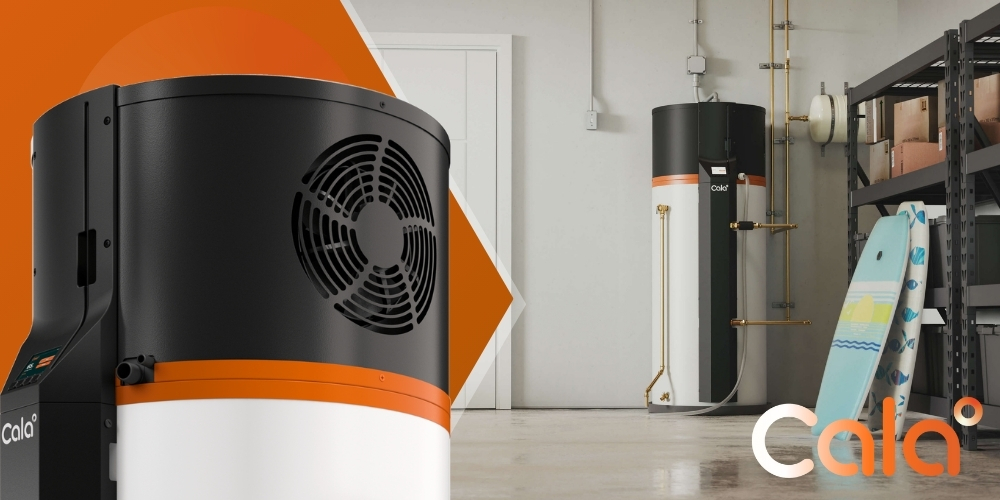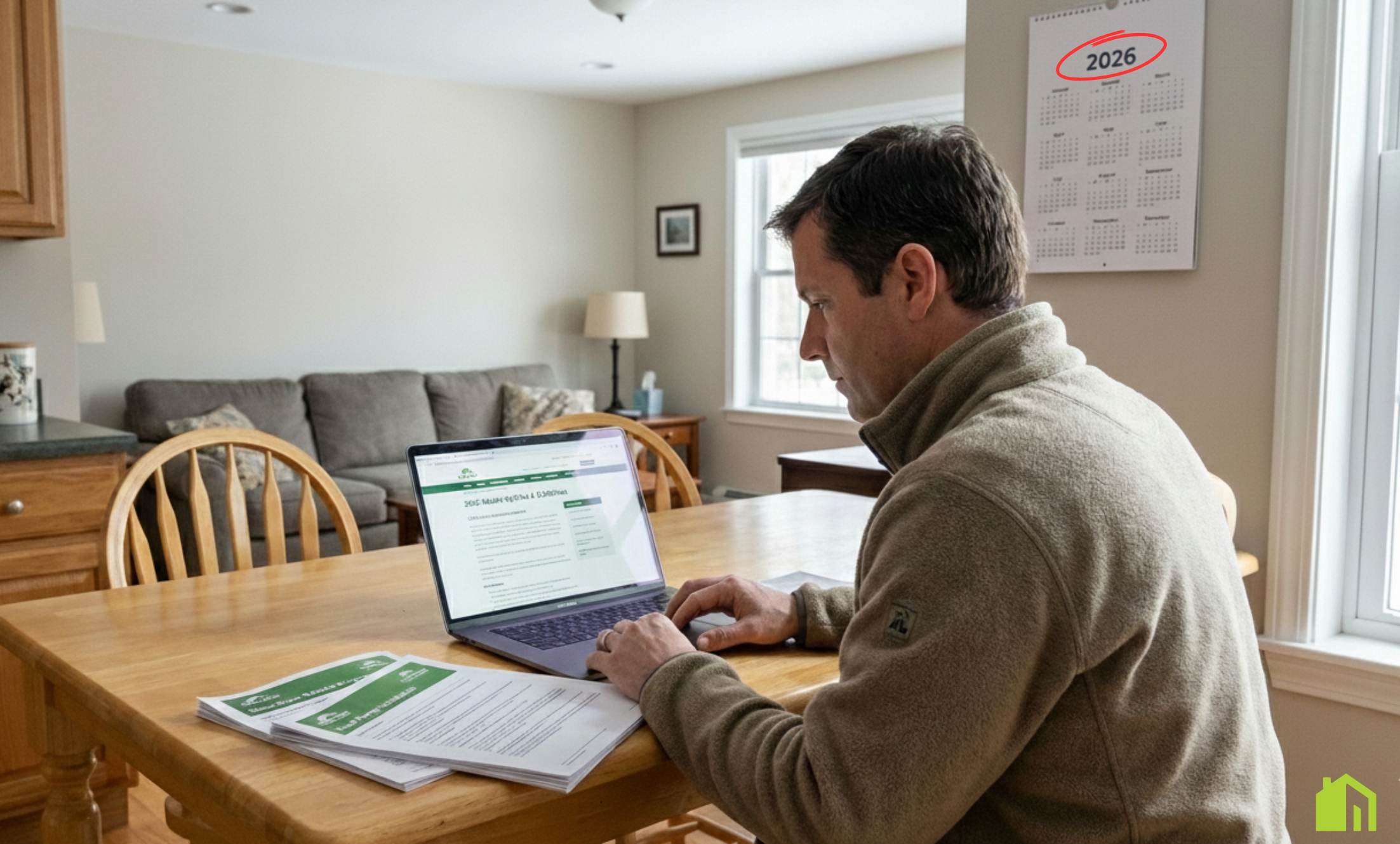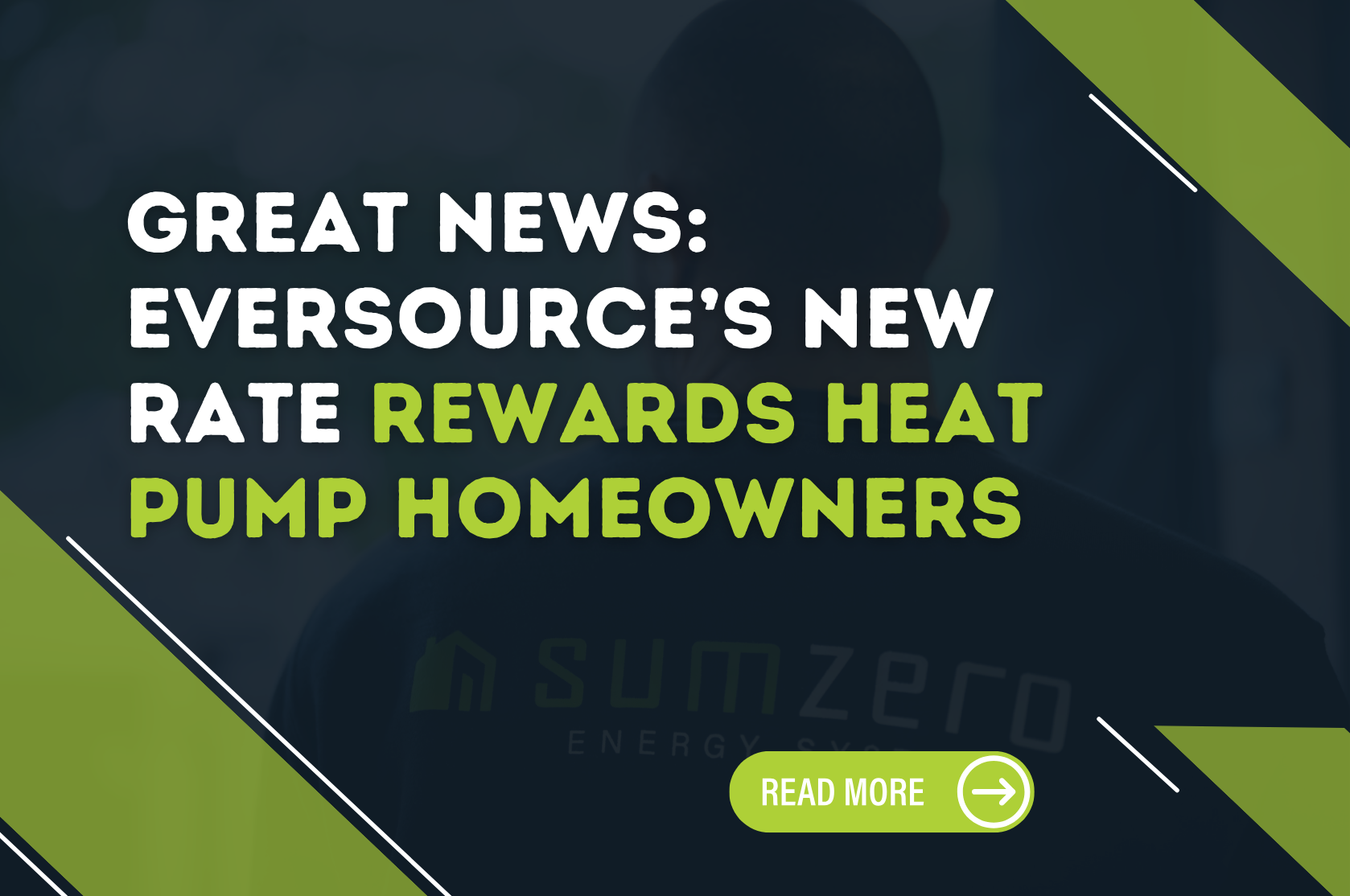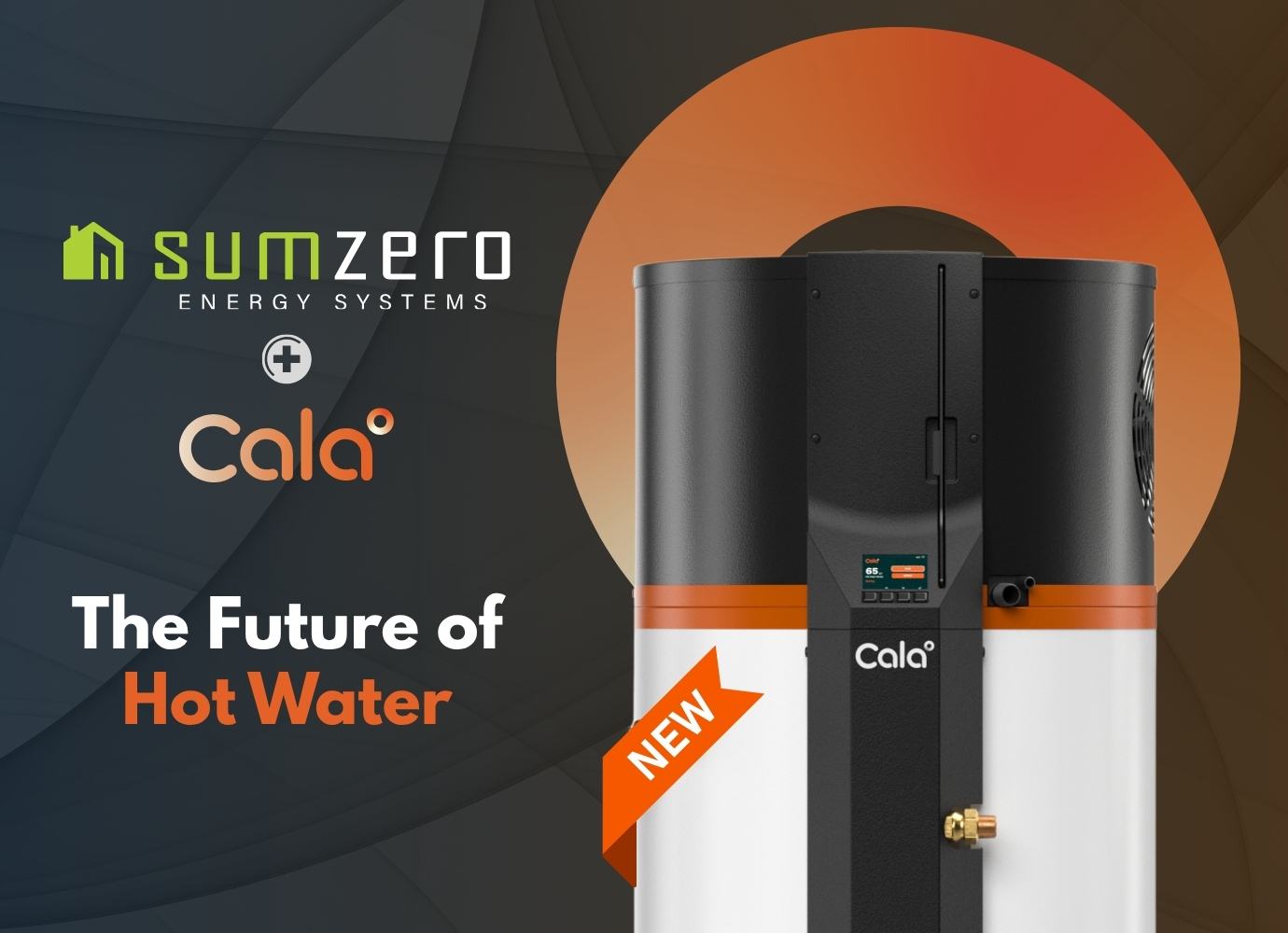ERV Maintenance Tips: Keeping Your Energy Recovery System Efficient

Intelligent Heat Pump Water Heaters for Massachusetts Residential Homes — Why SumZero Selects Cala
By SumZero Energy Systems — Massachusetts’ #1 Heat Pump Installation Team
Picking a new water heater once involved a simple decision between gas and standard old electric, praying the hot water wouldn't be gone when there were two showers in a row. That's no longer the case. Now, the ideal solution for the majority of Massachusetts homes is a smart heat pump water heater (HPWH). This isn't the typical hybrid of which you might have heard, but a rather new breed of unit that adapts to your home's schedule, accommodates your energy usage, and maintains comfort consistently while consuming a lot less energy.
When homeowners want to have it exactly right the first time, our team is discerning about what products we choose. We consider the landscape and inspect the details before determining that they might work with Cala, a company that produces a high-technology hot water heater that modern homes need: intelligent, consistent, and efficient hot water — installed properly. This article describes why this alliance matters, how the tech benefits your home, what you should expect from our installation, and the handy information (rebates, credits, fit questions) homeowners inquire about daily.
Why This Alliance Is Important
(and What It Does for You)
There are two parts to a successful hot water solution:
Great technology
A system that makes you comfortable and uses less energy.
Great installation
Design, placement, airflow, electrical, condensate handling, commissioning, and long-term support.
Cala provides a tailor-built, smart HPWH platform. SumZero provides actual-world experience so that it works perfectly in real Massachusetts homes.
Together, we provide three things homeowners report wanting:
Accurate hot water at peak periods without guessing.
Cheaper monthly energy bills without compromise on comfort.
It is a future-proof solution that addresses the trend towards greener, all-electric homes.
Simply put: We get hot water. We know how to properly install heat pump technology. This combination makes a water heater upgrade a smart, long-term decision.
The Homeowner's Dilemma That We Are
If you have had a gas or a typical electric water heater, then you know the problems:
Hot-cold swings on hectic morning routines.
Higher electricity bills than hoped for.
No real insight, no real control.
A replace cycle that is experienced as "buying the same thing again."
Typical hybrid: Heat pump water heaters perform better, yet they still react: They delay until the tank cools off, then warm it up again. Homeowners averred they desire a system which thinks ahead—a unit which is a breeze to operate, handles peak load graciously, and does not make them compromise.
They fill that gap, which is why we work with them.

Why a Smart HPWH is Different
A standard electric water heater makes heat by passing an electric element, a giant toaster coil, through the tank. A heat pump water heater does it another way: it takes heat from the air it lives in and puts it into the water. Because it costs less energy to move heat than create it, heat pump water heaters run on much less power than typical electric ones. And they avoid burning gas, venting, and pollution.
A smart HPWH goes one step further:
It adapts to your home's schedule (morning showers, nighttime laundry) and preheats when demand isn't yet high.
You can use the app to check, plan, or increase hot water whenever you want.
It has a compressor that can change speed to fit what you need (not just "on/off").
It is achievable with a mixing valve holding water at the proper warmth for improved efficiency and then providing a sustained, safe warmth for usage. This is also possible with the availability of additional warm water at peak usage times.
It goes nicely with a contemporary home — primed for solar, time-of-use, and information you can view at a glance.
Result: more stable comfort, less energy use, improved control.
Why a Smart HPWH is Different
From what is visible on-site, there are three things certain for homeowners regarding the points of Cala:
1) Ease That Is Effortless
Consistent hot water at peak use is the ultimate test. Through forecasting demand and using a mixing valve, Cala maintains a steady supply. That results in less "uh oh" when two showers coincidentally happen at once or someone turns on the dishwasher.
2) Controls That You'll Ever Use
App functionality is key when done properly. You can check if there's hot water, turn up the heat for guests, view energy usage history, or simply set it and leave. As installers, we appreciate performance data — it allows us to address little issues before large ones form.
3) Future-Ready from Day One
Massachusetts is going towards clean, electricity-based homes. Cala's strategy combines well: it is scalable for solar power and accounts for time-of-use rates when needed. If you foresee solar energy at some time, or already have it, this water heater won't stop your home from being efficient.
4) A Company That Stands Behind Its Product
Cala backs every unit with a 10-year parts warranty and 3-year labor warranty — a strong sign they stand behind both the technology and the people who install it. At SumZero, we respect that kind of commitment because it mirrors our own approach: taking care of homeowners and supporting our partners with the same level of trust and accountability.
What SumZero Offers As Your Installer
(Why It Matters)
Even the best system won't work so great if installed wrong. Our task is getting your new HPWH working perfectly inside your home, not on a drawing board. This is what our approach is:
Right-size design.
We measure how much water your home needs and discuss the high-flow fixtures, filling bathtubs, and washer usage.
Best installation and ventilation.
HPWHs require air to make the heat move. We consider the room size, doors, vents, and — when necessary — ducting solutions for high performance and low noise.
Clean handling of electricity and condensate.
Safe power, tidy routing, and a trustworthy drainage plan are essential.
Commissioning correctly.
We don't just "turn it on." We verify performance, position the mixing valve, help you with the app, and verify your comfort objectives.
Rebates, credits, and financial assistance.
Mass Save, federal 25C, and the 0% HEAT Loan (if applicable) — we'll help you with that.
We take special care.
Our teams respect your home, protect your floors, and leave the place nicer than they found it.
Aftercare you can count on. Questions years down the road? We're here. The whole concept of a smart system is long-term confidence, not a one-day installation.
Costs, Incentives, and Lifetime Value
Two parts matter here: upfront cost and operating cost.
→ It is a better unit than a standard electric or simple hybrid. Tax credits and rebates make a big difference. A lot of Massachusetts homeowners rely on the 0% HEAT Loan for easier payments.
→ Month after month, the intelligent HPWH's effectiveness is where the value lies. By transferring (not creating) heat and by scheduling heating intelligently, homeowners consistently experience significant decreases in water-heating energy consumption — particularly relative to resistance electric, and many times relative to gas or delivered fuels when full costs are factors.
If you'd like figures specific to your home (household number, showering usage, energy costs), we'll do the math at your consult and provide you with a clear estimate of payback, lifetime cost saving, and the rebates for which you qualify.
Are Smarter Heat Pump Water Heaters Good for Your Home?
It is feasible for many Massachusetts homes. We will cover:
→ Household size and routines. Families with up to about 5 people usually do well with the standard setup; we will give advice for larger families or special situations.
→ Space and ventilation. We check the space, door vents, or ducts if necessary, and ventilation so the system operates properly.
→ Location. Basements are typical, as are utility rooms. As the unit functions, it removes air that feels like a dehumidifier — a typical plus for basements.
→ Electrical. We check panel capacity and proper wiring; no installation day surprises.
→ Future plans. Now or in the future for solar? Time-of-use rates? We'll put the system on so it grows with your home.
[[cta-heatpump]]
Why Is Cala Different from "Traditional Hybrids"?
✪ Control and Convenience:
Cala integrates intelligent tech with a mixing valve to remain comfortable, even when it is busy. Most standard hybrid units have simple modes and react only when the tank becomes chilled.
✪ Care and Trust:
Performance insights help you recognize problems early on and keep you on your feet for surprises. Traditional deployments are mostly "wait and see."
✪ Timing and Efficiency:
Variable driving and improved scheduling assist in energy saving with the maintenance of comfort. Ordinary hybrids operate more often and at undesirable times.
✪ Future-Ready
The design of the Cala accommodates with solar power, intelligent homes, and plans for utilizing electricity. Most older hybrids were not built for that usage.

What to Expect with SumZero
(From the First Call Through the First Shower)
✪ Talk & Pictures
We'll first glance at your objectives and take some fast photos of the current installation: the water heating unit, panel, and surrounding room.
✪ Right-Fit Design
We fit your hot water consumption and available spaces to a design which we endorse.
✪ Chaplain: A Comprehensive
Your quote is going to be transparent, includes information for installation, accessories, and a checklist for incentives. The paperwork assistance takes care of our end.
✪ Professional Installation
Licensed, insured, and detail-orientated. We dispose of the old unit, prepare the site, install and commission a new system, and leave the site tidy.
✪ App Introduction and Instructions
You'll discover how to see hot water supply, schedule increases, and view consumption — without being "technical."
✪ Support and Help
We're your long-term partner. Got a question? You call us — that's what homeowners deserve from the #1 heat pump installation company.
Common Questions We Get
(And Easy Answers)
Smart heat pump water heaters move heat from the surrounding air into the water instead of generating heat directly. This makes them up to three to four times more efficient than standard electric models. Cala’s intelligent system takes it further — it learns your household’s patterns, preheats before busy periods, and gives you app-based control to monitor or boost hot water anytime.
Most hybrid water heaters react when the tank cools. Cala predicts when your home will need hot water and heats proactively, saving more energy while maintaining comfort. It also features a variable-speed compressor, integrated mixing valve, and performance monitoring portal, giving both homeowners and installers a smarter, more reliable experience.
Savings depend on your energy source and usage, but many Massachusetts homeowners cut their water-heating costs by 50–70% when switching to a heat pump system. Cala’s intelligent controls add even greater efficiency. Add Mass Save® rebates, federal 25C tax credits, and potential 0% HEAT Loan financing, and most families see real payback within just a few years.
Yes — most Massachusetts homes are a great fit. Cala’s 65-gallon design comfortably serves households up to five people and can prepare up to 90 gallons ahead of peak use. The system needs adequate space and airflow, similar to a dehumidifier, and our team at SumZero handles every detail — from placement and ducting to electrical and performance checks.
SumZero Energy Systems is Massachusetts’ #1 heat pump installation team, trusted for precision, transparency, and high-quality service. We manage every step — design, installation, rebate paperwork, app setup, and long-term maintenance — so homeowners enjoy smarter comfort and lasting confidence. With SumZero, you’re not just buying equipment; you’re gaining a partner who stands behind it.
Why We Feel Secure Recommending This to Massachusetts Homeowners
We have a simple promise: we only install solutions that we would use in our own homes. Cala’s approach — being smart, having control, and being ready for the future — matches what we have learned from many talks with homeowners in the state. Together with SumZero’s careful installation standards and ongoing support, this water-heating upgrade makes sense right away and will last well with your home. Cleaner heat. Smarter comfort. Fewer bills.
Ready to Take the Next Step?

To learn more about Cala’s technology and vision, visit Cala Systems.
Why Energy Recovery Ventilator Maintenance Matters
Keeping your energy recovery ventilation system in good shape isn't just about efficiency. For Massachusetts homeowners, it's also a matter of comfort and year-round energy savings. An energy recovery ventilator (ERV) works behind the scenes to exchange stale indoor air with fresh outdoor air—while conserving heating and cooling energy. But like any home system, it needs regular upkeep.
Most ERVs can lose up to 20% of their energy-saving capability if filters and parts aren’t cleaned or replaced on time.
Whether you're using a Panasonic, Fantech, or another recommended unit, regular ERV maintenance protects your investment and ensures your home’s indoor air quality stays high.
Key Components of an Energy Recovery Ventilation System
Understanding your ERV energy recovery ventilator helps make maintenance easier. Knowing where to focus your efforts ensures you don’t overlook items that impact efficiency the most.
What Is an Energy Recovery Ventilator?
A residential energy recovery ventilator improves air quality by bringing in outdoor air while exhausting stale indoor air. What makes it valuable is how it transfers heat and humidity between the incoming and outgoing air streams—reducing load on your heating and cooling system.
Main Parts to Monitor
Get familiar with these components so you know what requires cleaning or replacing:
- Filters: Trap dust, pollen, and debris from incoming air.
- Core exchanger: Transfers heat between airflows.
- Fans and motors: Circulate and balance both air streams.
- Drain pan or lines: Collect moisture to prevent mold growth.
Neglecting even one of these can reduce your system’s performance—and raise your energy bills in the process.
How to Perform Routine ERV Maintenance at Home
Basic ERV upkeep isn’t complicated. With a little routine attention, your energy recovery ventilation unit will keep performing efficiently for years to come. Below are maintenance tasks homeowners in Massachusetts can perform themselves throughout the year.
Cleaning the Air Filters
Filters are one of the most important elements to your system’s airflow and performance.
- Check filters every three months.
- Clean reusable filters with mild soap and warm water. Let dry fully before reinstalling.
- Replace disposable filters according to manufacturer recommendations (usually every 3–6 months).
A clogged ERV filter can feel like poor airflow in your home, but it’s often resolved with a simple cleaning.
Inspecting the Core Exchanger
The core exchanger is key to energy efficiency—so don’t skip this.
- Examine for dust buildup every six months.
- Use a soft brush or vacuum with a nozzle to remove dirt.
- Avoid using water unless the manual specifies it’s washable.
Routine cleaning can improve how well the exchanger conserves heat and humidity.
Checking the Ventilation Grilles and Ducts
All incoming and outgoing vents should stay clear.
- Look for dust or blockages on interior grilles every season.
- Ensure exterior intake and exhaust ducts are free of snow, leaves, or pests.
Blockages reduce airflow, which makes the ERV overwork and operate inefficiently.
Cleaning the Drain Pan and Condensate Lines
If your ERV energy recovery ventilator collects condensation, as many in Massachusetts do—this step is essential.
- Flush the drain lines with a diluted vinegar solution yearly to prevent clogs.
- Wipe down the pan if there's visible buildup or algae.
Ignoring drain maintenance can lead to water damage and mold, especially during humid summer months.
[[cta-heatpump]]
Seasonal Tips to Maximize Your ERV’s Efficiency
Massachusetts homeowners know the seasons bring big temperature swings. Your energy recovery ventilation system adapts to these shifts—but only if it’s maintained with the climate in mind.
Winter Preparation Steps
ERVs are especially valuable in colder months, retaining valuable indoor heat.
- Ensure the unit’s pre-heater (if installed) is functioning.
- Check exterior vents for ice or snow that might restrict airflow.
- Inspect weather stripping around ducts and seals to maintain airtightness.
A well-sealed system will help your ERV balance frigid outdoor air with warmer indoor temperatures more effectively.
Summer Maintenance Focus
In summer, ERVs reject unwanted humidity while bringing in cooler night air.
- Clean filters more frequently due to pollen and increased air contaminants.
- Confirm that condensation lines are draining properly to avoid overflow.
- Shade exterior vents where possible to prevent duct heat gain.
In summer, properly functioning ERVs can reduce your AC usage by improving nighttime cooling ventilation.
These seasonal steps protect not only your unit but also your energy bill. The goal is to let fresh air lower your demand on mechanical heating and cooling.
Consider Upgrading If Your Unit Is Over 10 Years Old
Older models of energy recovery ventilation systems can lag behind in performance and reliability. If you're finding that your ERV is noisier, less effective, or prone to breakdowns—it may be time to explore newer, more efficient options.
Modern systems from Mitsubishi Electric, Daikin, and Bosch HVAC offer quieter operation, boosted humidity controls, and built-in smart features tailored for New England’s diverse climate. Plus, a more efficient ERV may qualify for rebates through programs like Mass Save.
Final Thoughts on ERV Longevity and Savings
The consistent, quiet work your energy recovery ventilator does each day is easy to forget—but the benefits are far-reaching. Boosted indoor air quality, balanced humidity, and lower energy use are all tied to how well your unit is maintained.
Instead of waiting for reduced airflow or higher bills to remind you, make your ERV maintenance part of your seasonal home care routine. The better your unit breathes, the better your home does too.
By keeping filters clean, grilles clear, and components working smoothly, you'll extend the life of your system and maximize energy efficiency—all while keeping your Massachusetts home more comfortable, healthy, and cost-efficient year-round.
Keep your energy recovery ventilator running efficiently and your indoor air fresh—visit our service page to learn easy ERV maintenance tips that boost comfort and savings year-round.
Install Your ERV TodayYou Might Also Like…
Continue learning with handpicked articles that inform and inspire.
Not Sure Where to Start? We’ll Guide You
Let our experts design the right heating and cooling solution—customized for your comfort, your layout, and your energy goals. No pressure. Just clarity.
Request FREE ESTIMATE









